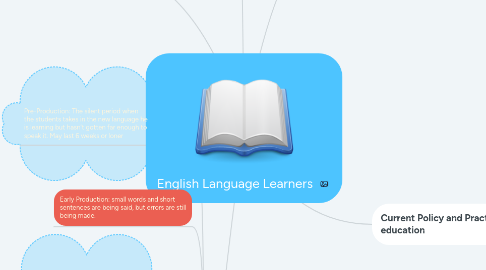English Language Learners
von Nathalia Osuna

1. Population- who are our ELL students and families?
1.1. 57 percent of adolescents ELL were born in the U.S, 43 percent were born elsewhere
1.2. The ELL population has decreased by 38 percent from 170,000 to 106,000
1.3. Many are immigrants and refugees but most of students are U.S citizens that come from immigrant parents and are enroll in a school here in the US.
1.4. From grades K-12 enrollments nation ELLs make up 10.5 percent.
2. Myths surrounding ELLS
2.1. Myth: Children Learn a second language quickly and easily. In reality some may learn it quickly but a lot of them come upon social cultural factors that can affect them with language learning. It can take a lot to learn something so new and get used to the new ways.
2.2. Myth: When an ELL student is able to speak English fluently, he or she has mastered it. Reality: I don't think you ever become a mastered at it new ways come out everyday so a refresher should always be encouraged because the native language is still being spoken at home even though English is spoken at school.
2.3. Myth: All ELL students learn English the same way. Reality everyone comes from different backgrounds and different languages and were brought up different so that creates a different way of learning per individual. Some already speak a language similar to English making it easier and others have it way different making it harder to learn.
2.4. Teaching ELLs means only focusing on vocabulary; Reality is that students need to learn how to put words together and the meaning behind writing a full sentence. When you only know words you lack on expressing yourself or giving your opinion because all you know if vocabulary and not hw to put words together.
3. Stages of Language Acquisition
3.1. Pre-Production: The silent period when the students takes in the new language he is learning but hasn't gotten far enough to speak it. May last 6 weeks or loner
3.2. Early Production: small words and short sentences are being said, but errors are still being made.
3.3. Beginning Fluency: Almost fluent in social situations, but will still struggle to express themself.
3.4. Intermediate Fluency: Communication is fluent in new language, they are able to think higher in new language like providing an opinion or overlooking a problem. Still a few gaps in vocabulary
3.5. Advanced Fluency: Individual is comfortable in second language, they are able to understand new information in new language. May still have an accent, but understands it.
3.6. It can take each individual about 5-7 years to get through these stages, and gain fluency in new language.
3.7. Speech Emergent: Sentences are longer speech is more frequently, errors decrease and vocabulary starts to get better.
4. History of English Language Learners
4.1. In 1968 the Bilingual Act (Title VII) recognized that ELL students required extra help and gave funds to support their learning.
4.2. In 2002 the NCLB Act replaced the Bilingual Act, One of the requirements NCLB had was that the school had to report yearly progress.
5. Current Policy and Practice in ELL education
5.1. Schools districts have students take an English home test to determine if they required to be in the ELL program
5.2. Every 1 year every student is tested and after two years of being in the ELL program they can be tested out or remain.
5.3. The School English Immersion (SEI) requires for teacher to used their materials to teach ELL students, 4 hours a day in a classroom setting for SEI practice the materials were designed to have students skilled in about 1 year.


